《大学英语语法 讲座与测试》
| 作者 | 徐广联主编 编者 |
|---|---|
| 出版 | 南京:东南大学出版社 |
| 参考页数 | 689 |
| 出版时间 | 1991(求助前请核对) 目录预览 |
| ISBN号 | 781050133X — 求助条款 |
| PDF编号 | 86977558(仅供预览,未存储实际文件) |
| 求助格式 | 扫描PDF(若分多册发行,每次仅能受理1册) |
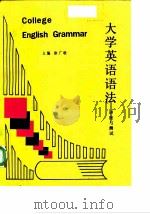
目录1
第一讲 冠词1
一、用定冠词与不使用定冠词的场合1
1.使用定冠词的场合1
1)用在表示独一无二的或被认为是唯一东西的名词前1
2)用在表示特指的人或物的名词前(熟知或心照不宣的人或物)1
3)用在第二次提到的人或物的名词前1
4)用在由短语或从句修饰的名词前1
5)用在形容词、副词最高级或序数词前;only,main,sole,same修饰名词时,前面也要用定冠词1
目录1
第一讲 冠词1
5)用在形容词、副词最高级或序数词前;only,main,sole,same修饰名词时,前面也要用定冠词1
4)用在由短语或从句修饰的名词前1
3)用在第二次提到的人或物的名词前1
2)用在表示特指的人或物的名词前(熟知或心照不宣的人或物)1
1)用在表示独一无二的或被认为是唯一东西的名词前1
1.使用定冠词的场合1
一、用定冠词与不使用定冠词的场合1
8)用在形容词、动名词、过去分词前表示同一类人或某种抽象概念(作主语时,谓语动词一般用复数)2
8)用在形容词、动名词、过去分词前表示同一类人或某种抽象概念(作主语时,谓语动词一般用复数)2
7)用在复数名词前表示某类人的总称或集体中的任何一个或多于一个2
7)用在复数名词前表示某类人的总称或集体中的任何一个或多于一个2
6)用在单数名词或形容词前表示类属2
6)用在单数名词或形容词前表示类属2
10)用在姓氏的复数形式前表示“一家人”3
9)用在表示海洋、河流、山脉、群岛、某些国名、某些组织机构、报纸、书籍、会议条约、信仰等名词前3
10)用在姓氏的复数形式前表示“一家人”3
9)用在表示海洋、河流、山脉、群岛、某些国名、某些组织机构、报纸、书籍、会议条约、信仰等名词前3
12)用在表示人名的专有名词前4
14)用在表示学校、星座、船只、飞机、三军、宗教事物、历史朝代等的名词前4
13)用在表示方位的名词前4
14)用在表示学校、星座、船只、飞机、三军、宗教事物、历史朝代等的名词前4
13)用在表示方位的名词前4
12)用在表示人名的专有名词前4
11)用在某些名词前表示民族、阶级、阶层4
11)用在某些名词前表示民族、阶级、阶层4
17)to the day,to a day和to this day5
18)next不同于the next,last不同于the last5
15)用在乐器名称前5
16)定冠词在一定场合具有every、each、per的含义,而且有时可以同不定冠词互换5
15)用在乐器名称前5
16)定冠词在一定场合具有every、each、per的含义,而且有时可以同不定冠词互换5
17)to the day,to a day和to this day5
18)next不同于the next,last不同于the last5
22)strike her in the eye但strike her eye6
20)the book that I want和a book that I want6
19)the cobra,a cobra和cobras6
20)the book that I want和a book that I want6
21)on the fly和on the go中的the不可省6
22)strike her in the eye但strike her eye6
21)on the fly和on the go中的the不可省6
19)the cobra,a cobra和cobras6
24)to the ear和to the eye的含义7
23)in the seventies中的the不可省7
25)the red and the white roses不同于the red and white roses7
25)the red and the white roses不同于the red and white roses7
24)to the ear和to the eye的含义7
23)in the seventies中的the不可省7
26)the“Queen Elizabeth”不是Queen Elizabeth,the“Turner”不是Turner8
27)by train和catch the train8
28)定冠词有时用在名人的姓名前8
30)定冠词可以表示对照8
31)人名前若有形容词修饰,表示人的特征、性质或某种情感时,要用定冠词8
5)“It(This)is the first time that…”结构中的从句要求用现在完成时…………3?6)“It(This)is the best(worst,nost interesting)+名词+that…”结构中的从句要求用现在完成时 ?8
29)定冠词可以表示与人体密切相关的事物8
5)“It(This)is the first time that…”结构中的从句要求用现在完成时…………3?6)“It(This)is the best(worst,nost interesting)+名词+that…”结构中的从句要求用现在完成时 ?8
31)人名前若有形容词修饰,表示人的特征、性质或某种情感时,要用定冠词8
27)by train和catch the train8
28)定冠词有时用在名人的姓名前8
29)定冠词可以表示与人体密切相关的事物8
30)定冠词可以表示对照8
26)the“Queen Elizabeth”不是Queen Elizabeth,the“Turner”不是Turner8
36)the variety of不同于a variety of9
35)actthe lover——定冠词的典型意义9
34)community等词前常用定冠词9
33)听、说双方所共指或作同一理解的知名人士的名字前,要用定冠词9
32)人名带有后置定语,前面要用定冠词9
32)人名带有后置定语,前面要用定冠词9
33)听、说双方所共指或作同一理解的知名人士的名字前,要用定冠词9
34)community等词前常用定冠词9
35)actthe lover——定冠词的典型意义9
36)the variety of不同于a variety of9
38)some of the students和some of students10
38)some of the students和some of students10
39)定冠词表示部分10
40)有些惯用短语要求用定冠词10
37)twice the speed和twice a minute10
37)twice the speed和twice a minute10
39)定冠词表示部分10
40)有些惯用短语要求用定冠词10
4)表示日期、月份、季节、日、夜、早、晚、周、年等的名词前一般不用定冠词11
5)表示运动及游戏的名词前一般不用定冠词11
2.不使用定冠词的场合11
1)当名词前有物主代词、指示代词、疑问代词、不定代词和数词等限定词时,不用定冠词11
2)在表示人名、地名的专有名词前(由普通名词构成的专有名词除外),一般不用定冠词11
3)表示一日三餐的名词前一般不用定冠词11
1)当名词前有物主代词、指示代词、疑问代词、不定代词和数词等限定词时,不用定冠词11
5)表示运动及游戏的名词前一般不用定冠词11
2.不使用定冠词的场合11
4)表示日期、月份、季节、日、夜、早、晚、周、年等的名词前一般不用定冠词11
3)表示一日三餐的名词前一般不用定冠词11
2)在表示人名、地名的专有名词前(由普通名词构成的专有名词除外),一般不用定冠词11
6)表示颜色的名词前一般不用定冠词12
9)用作同位语或主语补足语以说明身份、职位、头衔等的名词前一般不用定冠词12
8)表示学科的名词前一般不用定冠词12
7)表示语言的名词前一般不用定冠词12
6)表示颜色的名词前一般不用定冠词12
7)表示语言的名词前一般不用定冠词12
8)表示学科的名词前一般不用定冠词12
9)用作同位语或主语补足语以说明身份、职位、头衔等的名词前一般不用定冠词12
11)成对使用的名词或名词、形容词固定搭配,一般不用定冠词13
10)表示家人的名词前可以不用定冠词,但该名词的第一个字母要大写13
10)表示家人的名词前可以不用定冠词,但该名词的第一个字母要大写13
11)成对使用的名词或名词、形容词固定搭配,一般不用定冠词13
15)four of us和the four of us14
14)方位词用作状语时,前面不用定冠词14
13)由具体转为抽象的名词前一般不用定冠词14
15)four of us和the four of us14
14)方位词用作状语时,前面不用定冠词14
13)由具体转为抽象的名词前一般不用定冠词14
12)新闻标题前一般省略定冠词14
12)新闻标题前一般省略定冠词14
16)形容词最高级前不加定冠词的五种情况15
16)形容词最高级前不加定冠词的五种情况15
17)抽象名词、复数名词和单数集体名词前一般不用定冠词16
18)by letter等习语中不用定冠词16
19)有些惯用短语要求不用定冠词16
17)抽象名词、复数名词和单数集体名词前一般不用定冠词16
18)by letter等习语中不用定冠词16
19)有些惯用短语要求不用定冠词16
二.使用不定冠词与不使用不定冠词的场合18
1.使用不定冠词的场合18
6)用在某些表示情绪的抽象名词前,表示“一种、一类”等18
5)用在某些物质名词前,表示“一阵、一份、一类、一场”等18
4)用在姓名前或Mr./Mrs./Miss/Ms.+姓氏前,表示“某一个…”,有不肯定的意味18
3)用在某些数目的表示法中18
2)用在可数名词前,表示一类人或物18
二.使用不定冠词与不使用不定冠词的场合18
1.使用不定冠词的场合18
1)表示“一”这个数量18
2)用在可数名词前,表示一类人或物18
3)用在某些数目的表示法中18
4)用在姓名前或Mr./Mrs./Miss/Ms.+姓氏前,表示“某一个…”,有不肯定的意味18
5)用在某些物质名词前,表示“一阵、一份、一类、一场”等18
6)用在某些表示情绪的抽象名词前,表示“一种、一类”等18
1)表示“一”这个数量18
9)more than a year不同于more than one year19
9)more than a year不同于more than one year19
8)表示“每一”,相当于each19
7)at a time和at one time19
8)表示“每一”,相当于each19
7)at a time和at one time19
13)turn writer还是turn a writer20
12)a mountain of a wave中的a不可换成one20
11)so cold a day不可说成so cold one day20
10)birds of a feather的含义20
10)birds of a feather的含义20
11)so cold a day不可说成so cold one day20
12)a mountain of a wave中的a不可换成one20
13)turn writer还是turn a writer20
17)表示“那种”,相当于such a;也表示“任何”,相当于any21
15)用在名词化的动名词、形容词、过去分词或序数词等前21
16)表示言外之意21
17)表示“那种”,相当于such a;也表示“任何”,相当于any21
14)a Gorky,a contented Mary和a Qi Bei-shi中的a指什么?21
15)用在名词化的动名词、形容词、过去分词或序数词等前21
16)表示言外之意21
14)a Gorky,a contented Mary和a Qi Bei-shi中的a指什么?21
20)用a还是用one22
20)用a还是用one22
18)a red and blue pencil不同于a red and a blue pencil22
18)a red and blue pencil不同于a red and a blue pencil22
19)有些名词通常成对出现(被视为一体),一般只用一个不定冠词22
19)有些名词通常成对出现(被视为一体),一般只用一个不定冠词22
21)Manya little makes a mickle——不定冠词的位置难点23
21)Manya little makes a mickle——不定冠词的位置难点23
22)冠词同half的搭配问题24
22)冠词同half的搭配问题24
24)序数词表示“再一,又一”的意思时,用不定冠词25
25)to a fault不同于at fault25
24)序数词表示“再一,又一”的意思时,用不定冠词25
23)用a还是用an25
25)to a fault不同于at fault25
23)用a还是用an25
26)有些惯用短语要求用不定冠词26
26)有些惯用短语要求用不定冠词26
2)物质名词前一般不用不定冠词,但有些物质名词指具体的东西时,可用不定冠词27
3)抽象名词如beauty,hope,death,happiness,Strength等前一般不用不定冠词,但当这些词表示某种具体的、特指的含义时,可用不定冠词27
5)在一些习惯用语中,不用不定冠词27
3)抽象名词如beauty,hope,death,happiness,Strength等前一般不用不定冠词,但当这些词表示某种具体的、特指的含义时,可用不定冠词27
4)一日三餐的名词前一般不用不定冠词,但名词前有形容词时例外27
5)在一些习惯用语中,不用不定冠词27
1)不可数名词前一般不使用不定冠词,通常用some,any,a little,a piece of等表示数量27
2.不使用不定冠词的场合27
4)一日三餐的名词前一般不用不定冠词,但名词前有形容词时例外27
2)物质名词前一般不用不定冠词,但有些物质名词指具体的东西时,可用不定冠词27
1)不可数名词前一般不使用不定冠词,通常用some,any,a little,a piece of等表示数量27
2.不使用不定冠词的场合27
6)在并列使用的单数名词前,不定冠词可以省略28
7)fool as Jim is还是a fool as Jim is28
3.在单数类名词变为物质名词或抽象名词时28
8)(a)kind(species)of+名词结构中的名词前要加不定冠词吗?28
9)在独立结构中,coat off,head down,and pen in hand中的coat,head,pen前面要加不定冠词吗?28
三.既不用定冠词,也不用不定冠词的场合28
1.在介词后表示抽象概念的名词前28
2.在“形容词+of+表示身体部位的单数名词”结构中28
3.在单数类名词变为物质名词或抽象名词时28
2.在“形容词+of+表示身体部位的单数名词”结构中28
1.在介词后表示抽象概念的名词前28
三.既不用定冠词,也不用不定冠词的场合28
9)在独立结构中,coat off,head down,and pen in hand中的coat,head,pen前面要加不定冠词吗?28
8)(a)kind(species)of+名词结构中的名词前要加不定冠词吗?28
7)fool as Jim is还是a fool as Jim is28
6)在并列使用的单数名词前,不定冠词可以省略28
8.表示某一范围之内或某一情况之中的有限类指29
10.泛指人类或男女29
9.在一些并列结构中29
7.在某些短语中29
6.在呼语中29
5.为人熟知的事物29
4.表示一纯概念,无所指,无单、复数概念29
11.被认为是不可数的或复数形式的疾病名词前不用冠词29
5.为人熟知的事物29
6.在呼语中29
7.在某些短语中29
8.表示某一范围之内或某一情况之中的有限类指29
9.在一些并列结构中29
10.泛指人类或男女29
11.被认为是不可数的或复数形式的疾病名词前不用冠词29
4.表示一纯概念,无所指,无单、复数概念29
12.序数词前不用冠词的四种情况30
12.序数词前不用冠词的四种情况30
测试练习(一)30
测试练习(一)30
4.序数词的缩写31
1.一般序数词的形式31
4.序数词的缩写31
1.一般序数词的形式31
1.基数词中1~12是独立单词,13~19的基数词以后缀-teen结尾,20~90八个整十位数词以后缀-ty结尾32
一.基数词32
第二讲 数词32
2.表示其他两位数词,十位数与个位数之间需用连字符号“-”32
3.百位数与十位数之间,在英国要用“and”连接,在美国一般不用32
4.英语中“万”的表示法32
5.百万以上的数,英美表示法有所不同32
6.表示确指数字时,ten,hundred,thousand,million只用单数形式,不能加“s”32
6.表示确指数字时,ten,hundred,thousand,million只用单数形式,不能加“s”32
5.百万以上的数,英美表示法有所不同32
4.英语中“万”的表示法32
3.百位数与十位数之间,在英国要用“and”连接,在美国一般不用32
2.表示其他两位数词,十位数与个位数之间需用连字符号“-”32
1.基数词中1~12是独立单词,13~19的基数词以后缀-teen结尾,20~90八个整十位数词以后缀-ty结尾32
一.基数词32
第二讲 数词32
9.基数词可以表示年代、时刻、书页、住所、房间、教室、电话号码等33
8.数词常与名词连用构成复合定语,中间要用连字符,而且只用名词的单数形式33
9.基数词可以表示年代、时刻、书页、住所、房间、教室、电话号码等33
7.dozen(12)、score(20)、brace(1对)、head(1头)、yoke(1对牛)、gross(1箩)等表示精确数字时不用复数形式,但在表示不确切数字时要用复数33
8.数词常与名词连用构成复合定语,中间要用连字符,而且只用名词的单数形式33
7.dozen(12)、score(20)、brace(1对)、head(1头)、yoke(1对牛)、gross(1箩)等表示精确数字时不用复数形式,但在表示不确切数字时要用复数33
二.序数词34
2.以-ty结尾的基数词如何变成序数词34
3.两位数的基数词如何变成序数词34
三.倍数的表示法34
1.英语中的倍数即可以表示增加,也可以表示减少34
2.英语中“2倍、3倍”等的表示法34
二.序数词34
2.以-ty结尾的基数词如何变成序数词34
3.两位数的基数词如何变成序数词34
三.倍数的表示法34
1.英语中的倍数即可以表示增加,也可以表示减少34
2.英语中“2倍、3倍”等的表示法34
4)(half)as much(many,large)again as35
3.倍数比较的表示法35
4)(half)as much(many,large)again as35
3)X times+the width(length,breadth,level,value,velocity)of35
2)X times+形容词或副词比较级+than35
1)X times+as+形容词或副词原级+as35
3)X times+the width(length,breadth,level,value,velocity)of35
2)X times+形容词或副词比较级+than35
1)X times+as+形容词或副词原级+as35
3.倍数比较的表示法35
4.倍数增减的表示法36
1)increase(speed up,step up,raise,rise,go up,gow)+by+数字百分比或倍数36
2)increase(be,rise,grow,multiply,go up)+数词+times或fold36
3)multiply X times和be multiplied by36
4)increase(exceed,go up,rise…)+by a factor of+数词36
5)decrease(drop,fall,weaken,step down,speed down,go down)+by+数词36
7)倍数+upon(over)36
4.倍数增减的表示法36
1)increase(speed up,step up,raise,rise,go up,gow)+by+数字百分比或倍数36
2)increase(be,rise,grow,multiply,go up)+数词+times或fold36
3)multiply X times和be multiplied by36
4)increase(exceed,go up,rise…)+by a factor of+数词36
5)decrease(drop,fall,weaken,step down,speed down,go down)+by+数词36
6)increase(rise,decrease,reduce…)to36
7)倍数+upon(over)36
6)increase(rise,decrease,reduce…)to36
11)倍数表达方式的再比较37
10)six feet square和six square feet37
9)“减少一半”的表示法37
8)倍数+what+从句37
8)倍数+what+从句37
9)“减少一半”的表示法37
10)six feet square和six square feet37
11)倍数表达方式的再比较37
四.概数的表示法38
1.over,above,more than+数字或数字+odd38
2.below,under,less than+数字38
1.over,above,more than+数字或数字+odd38
2.below,under,less than+数字38
3.about,nearly,some,toward(s),more or less+数字或“数字+or so”,有时也可把more or less放在后面38
五.“每隔”与“每逢”的表示法38
六.一些数学公式、小数、分数、度量等的表示法38
3.about,nearly,some,toward(s),more or less+数字或“数字+or so”,有时也可把more or less放在后面38
五.“每隔”与“每逢”的表示法38
六.一些数学公式、小数、分数、度量等的表示法38
四.概数的表示法38
2.年龄表示法40
八.币制的表示法40
九.数词的其他用法40
1.年代表示法:the+基数词复数形式40
2.年龄表示法40
七.英、美楼层的不同表示法40
八.币制的表示法40
九.数词的其他用法40
1.年代表示法:the+基数词复数形式40
七.英、美楼层的不同表示法40
3.用阿拉伯数字表示复数数词时,阿拉伯数字后加s或’s41
3.用阿拉伯数字表示复数数词时,阿拉伯数字后加s或’s41
6.数词的限定语42
5.时刻表示法42
4.数词构成的固定词组42
4.数词构成的固定词组42
5.时刻表示法42
6.数词的限定语42
测试练习(二)43
测试练习(二)43
一.分类46
二.功能46
1.人称代词46
第三讲 代词46
1)当一个句子中有两个或两个以上人称代词时,语法功能相同的代词形式应该一致46
2)人称代词可以表示动物46
3)人称代词可以表示拟人(地球、月亮、党派、国家、车辆等),以表示喜爱或亲昵等46
4)人称代词有时可以用作名词46
2)人称代词可以表示动物46
第三讲 代词46
一.分类46
二.功能46
1.人称代词46
1)当一个句子中有两个或两个以上人称代词时,语法功能相同的代词形式应该一致46
4)人称代词有时可以用作名词46
3)人称代词可以表示拟人(地球、月亮、党派、国家、车辆等),以表示喜爱或亲昵等46
7)at one’s best不同于at best47
5)如果几个人称代词并列,应注意其排列次序47
6)人称代词应与其所代替的那个词在人称和数方面保持一致47
5)如果几个人称代词并列,应注意其排列次序47
6)人称代词应与其所代替的那个词在人称和数方面保持一致47
7)at one’s best不同于at best47
2.it的用法48
3)作先行代词,代替不定式,作形式主语或形式宾语48
4)作先行代词,代替动名词48
2.it的用法48
1)指代事物、动物、婴儿或未知的人48
8)for the life of me的含义48
8)for the life of me的含义48
2)指天气、时间、距离、自然现象、环境等48
2)指天气、时间、距离、自然现象、环境等48
4)作先行代词,代替动名词48
1)指代事物、动物、婴儿或未知的人48
3)作先行代词,代替不定式,作形式主语或形式宾语48
8)可以用来替代整个句子或句中谓语部分所表示的意思49
7)可以指复数名词49
6)用于强调句中49
5)作先行代词,代替名词性从句49
6)用于强调句中49
7)可以指复数名词49
8)可以用来替代整个句子或句中谓语部分所表示的意思49
5)作先行代词,代替名词性从句49
12)have it that的含义50
12)have it that的含义50
11)for it的含义50
10)it that可以引导宾语从句50
9)用it组成的惯用语50
11)for it的含义50
10)it that可以引导宾语从句50
9)用it组成的惯用语50
13)think it one’s duty to do sth.结构51
3.物主代词51
1)物主代词有形容词性和名词性两种51
2)her or his paper还是his or her paper51
3)名词性物主代词与of连用,可构成双重所有格51
4)动名词前一般使用形容词性物主代词51
3.物主代词51
13)think it one’s duty to do sth.结构51
1)物主代词有形容词性和名词性两种51
2)her or his paper还是his or her paper51
3)名词性物主代词与of连用,可构成双重所有格51
4)动名词前一般使用形容词性物主代词51
5)of one’s own的含义52
6)touch sb.on the head还是touch sb.on one’s head52
7)非物主意义的物主代词52
4.指示代词52
1)指代前面提到过的事物,常用that或those52
5)of one’s own的含义52
6)touch sb.on the head还是touch sb.on one’s head52
7)非物主意义的物主代词52
4.指示代词52
1)指代前面提到过的事物,常用that或those52
7)Alas,that Spring should vanish with the Rose中that的含义53
2)指代将要提及的事物,常用this或these53
3)this和these指的是在地点、时间等方面较近的事物,that和those指的是在地点、时间等方面较远的事物53
4)要求用this或these的特定场合53
5)要求用that的特定场合53
6)this day的一种特殊用法53
7)Alas,that Spring should vanish with the Rose中that的含义53
5)要求用that的特定场合53
6)this day的一种特殊用法53
2)指代将要提及的事物,常用this或these53
3)this和these指的是在地点、时间等方面较近的事物,that和those指的是在地点、时间等方面较远的事物53
4)要求用this或these的特定场合53
1)All is well that ends well——all的用法要点54
5.不定代词54
10)for them involved in the case还是for those involved in the case54
9)A good man,that——用指示代词重复前面所讲的事物,表示强调54
9)A good man,that——用指示代词重复前面所讲的事物,表示强调54
8)He left the day that I arrived中的that不是指示代词54
8)He left the day that I arrived中的that不是指示代词54
1)All is well that ends well——all的用法要点54
5.不定代词54
10)for them involved in the case还是for those involved in the case54
2)both的用法和结构56
2)both的用法和结构56
3)either的用法和结构57
3)either的用法和结构57
4)any及其复合词的用法和结构58
4)any及其复合词的用法和结构58
5)each of his eyes还是every one of his eyes——each的用法要点59
5)each of his eyes还是every one of his eyes——each的用法要点59
6)One must know oneself的含义——one的用法要点60
6)One must know oneself的含义——one的用法要点60
7)other的用法和结构62
7)other的用法和结构62
8)another的用法和结构63
8)another的用法和结构63
12)most的用法和结构65
9)one,other和another如何表示数目65
10)one,other和another如何表示对比65
11)one,other和another如何表示三者、四者65
12)most的用法和结构65
11)one,other和another如何表示三者、四者65
10)one,other和another如何表示对比65
9)one,other和another如何表示数目65
13)such lovely hills还是so lovely hills——such的用法和结构68
13)such lovely hills还是so lovely hills——such的用法和结构68
14)不可以说Of the three girls,the former is70
15)Rain or shine,it’s the same to me——same的用法和结构70
14)不可以说Of the three girls,the former is70
15)Rain or shine,it’s the same to me——same的用法和结构70
16)each other和one another71
18)several的用法71
17)many,much和 a lot(of)71
16)each other和one another71
17)many,much和 a lot(of)71
18)several的用法71
1)反身代词的一般用法72
1)反身代词的一般用法72
7.反身代词72
6.疑问代词72
7.反身代词72
6.疑问代词72
3)talk oneself hoarse中的反身代词73
2)反身代词用在avail,behave等动词后73
3)talk oneself hoarse中的反身代词73
2)反身代词用在avail,behave等动词后73
8)表示比较时,用在like,than,so,as后74
7)Alice is not quite herself的含义74
6)beside him不同于beside himself74
5)make a show of oneself中的反身代词74
4)find oneself in a dilemma中的反身代词74
8)表示比较时,用在like,than,so,as后74
7)Alice is not quite herself的含义74
6)beside him不同于beside himself74
5)make a show of oneself中的反身代词74
4)find oneself in a dilemma中的反身代词74
9)between ourselves——反身代词构成的惯用语75
10)反身代词作主语75
9)between ourselves——反身代词构成的惯用语75
11)hurt him和hurt himself75
10)反身代词作主语75
11)hurt him和hurt himself75
8.代词的一些其他用法76
1)those常用作后接定语从句中关系代词的先行词76
2)itself可以放在一个抽象名词后,用来加强该名词的含义76
3)one,it和that作替代词的差异76
4)no one和none的区别76
8.代词的一些其他用法76
1)those常用作后接定语从句中关系代词的先行词76
4)no one和none的区别76
3)one,it和that作替代词的差异76
2)itself可以放在一个抽象名词后,用来加强该名词的含义76
5)All men are not honest的含义77
7)as much as he和as much as him77
6)人称代词作主语但用宾格形式的几种情况77
7)as much as he和as much as him77
6)人称代词作主语但用宾格形式的几种情况77
5)All men are not honest的含义77
10)you,they和we泛指“人们”时的差异78
9)something和somebody也可以用作名词78
8)no能用作代词吗?78
10)you,they和we泛指“人们”时的差异78
9)something和somebody也可以用作名词78
8)no能用作代词吗?78
11)members of the same school winning the prize还是members of the same school’swinning the prize79
12)something of,nothing of,anything of和much of79
11)members of the same school winning the prize还是members of the same school’swinning the prize79
12)something of,nothing of,anything of和much of79
13)a lady who I believe is reliable不同于a lady whom I believe(to be)reliable——关系代词疑点79
13)a lady who I believe is reliable不同于a lady whom I believe(to be)reliable——关系代词疑点79
14)we的特殊意义80
15)hers of him的含义80
16)this和that能否作形式主语或形式宾语80
14)we的特殊意义80
15)hers of him的含义80
16)this和that能否作形式主语或形式宾语80
测试练习(三)81
测试练习(三)81
第四讲 介词85
一.分类85
1.简单介词85
2.成语介词85
二.位置85
1.介词通常位于名词或代词前85
2.在某些结构中,介词可以放在句尾85
1)在介词+whom/which/what/whose结构位于句首的疑问句中,介词可以放在句尾85
2)定语从句中位于that/whom/which之前的介词也可以放在句尾。在这种情况下,关系代词可以省略85
第四讲 介词85
一.分类85
1.简单介词85
2.成语介词85
二.位置85
1.介词通常位于名词或代词前85
2.在某些结构中,介词可以放在句尾85
1)在介词+whom/which/what/whose结构位于句首的疑问句中,介词可以放在句尾85
2)定语从句中位于that/whom/which之前的介词也可以放在句尾。在这种情况下,关系代词可以省略85
3.在“动词+介词”结构中,介词紧跟动词后86
3.在“动词+介词”结构中,介词紧跟动词后86
三.介词的宾语86
3)某些wh-名词性从句中,关系代词为介词宾语位于从句句首时,介词应后置86
三.介词的宾语86
5)动词不定式作定语,需要介词同动词不定式所修饰的名词构成介宾关系时,介词应后置86
5)动词不定式作定语,需要介词同动词不定式所修饰的名词构成介宾关系时,介词应后置86
4)动词不定式作状语,需要介词同句中主语构成介宾关系时,介词应后置86
3)某些wh-名词性从句中,关系代词为介词宾语位于从句句首时,介词应后置86
4)动词不定式作状语,需要介词同句中主语构成介宾关系时,介词应后置86
四.介词的语法功能87
四.介词的语法功能87
2.above88
1.about88
五.常见介词用法例解88
2.above88
1.about88
五.常见介词用法例解88
5.at89
4.against89
3.after89
3.after89
4.against89
5.at89
8.but91
7.beyond91
6.before91
6.before91
7.beyond91
8.but91
9.by92
10.for92
9.by92
10.for92
11.from93
12.in93
11.from93
12.in93
13.into95
14.of95
13.into95
14.of95
15.on96
15.on96
16.out of97
16.out of97
17.to98
17.to98
18.under99
18.under99
1)at100
1.表示时间的介词100
19.with100
六.表示时间、地点、原因、关于、方法、价格、特性、进行等的介词(短语)用法要点100
1.表示时间的介词100
1)at100
19.with100
六.表示时间、地点、原因、关于、方法、价格、特性、进行等的介词(短语)用法要点100
3)on101
2)in101
2)in101
3)on101
5)during和in102
4)of102
4)of102
5)during和in102
7)after和in的差异103
7)after和in的差异103
6)during和for差异103
6)during和for差异103
8)in和for的差异104
9)since和after的差异104
8)in和for的差异104
9)since和after的差异104
10)after和behind的差异105
11)to,till和until105
12)by105
13)as105
11)to,till和until105
14)inside of105
12)by105
13)as105
14)inside of105
10)after和behind的差异105
15)with+名词106
16)from和since106
17)as from和as of106
18)come Christmas的含义106
1)at,in和on106
15)with+名词106
16)from和since106
17)as from和as of106
18)come Christmas的含义106
2.表示地点和位置的介词106
1)at,in和on106
2.表示地点和位置的介词106
4)above和below108
3)under和over108
2)on和underneath108
2)on和underneath108
3)under和over108
4)above和below108
7)near和next to109
5)beneath109
6)at,by和beside109
7)near和next to109
6)at,by和beside109
5)beneath109
10)at the back of和back of110
9)behind和after110
8)before和in front of110
8)before和in front of110
9)behind和after110
10)at the back of和back of110
13)for,from,to,towards和by111
12)about,with,by和on的差异111
11)about,round和around111
11)about,round和around111
12)about,with,by和on的差异111
13)for,from,to,towards和by111
14)in和into的差异112
15)inside和within112
15)inside和within112
14)in和into的差异112
16)along,across,by,through,beyond和past113
16)along,across,by,through,beyond和past113
17)through,over和throughout的差异114
18)up和down114
17)through,over和throughout的差异114
18)up和down114
20)between,among和amidst116
19)from和off的差异116
19)from和off的差异116
20)between,among和amidst116
3.表示原因或理由的介词117
1)of117
1)of117
3.表示原因或理由的介词117
6)by118
3)for118
6)by118
2)from118
4)with118
5)through118
2)from118
5)through118
4)with118
3)for118
7)in119
8)at119
10)due to119
11)owing to119
7)in119
8)at119
9)on119
10)due to119
11)owing to119
9)on119
12)because of120
13)thanks to120
4.表示“关于、至于”的介词120
1)in regard to,with regard to,regarding和as regards120
2)concerning,respecting和touching120
12)because of120
3)with respect to,in respect of,with(in)reference to和in the matter of120
3)with respect to,in respect of,with(in)reference to和in the matter of120
2)concerning,respecting和touching120
1)in regard to,with regard to,regarding和as regards120
4.表示“关于、至于”的介词120
13)thanks to120
5.表示方法、手段或工具的介词121
1)by121
1)by121
5.表示方法、手段或工具的介词121
2)with和by的差异122
2)with和by的差异122
3)on123
3)on123
4)in124
4)in124
6.表示价格、比率、标准、对比、速度的介词124
1)at124
1)at124
6.表示价格、比率、标准、对比、速度的介词124
2)by125
2)by125
4)to126
3)than126
3)than126
4)to126
5)above127
7.表示特性、属性的介词127
5)above127
7.表示特性、属性的介词127
1)of127
1)of127
2)with129
8.引出间接宾语的介词129
1)用to引出间接宾语的动词129
2)用for引出间接宾语的动词129
2)with129
8.引出间接宾语的介词129
1)用to引出间接宾语的动词129
2)用for引出间接宾语的动词129
9.表示进行意义的介词130
1)at+名词130
9.表示进行意义的介词130
1)at+名词130
4)under+名词131
七.介词和介词短语的惯用法难点131
1.on time,in time和in good time131
2.at the beginning of,at first,in the beginning,at last,at the end of和in the end131
3)on(the)+名词131
2.at the beginning of,at first,in the beginning,at last,at the end of和in the end131
2)in(the)+名词+of131
2)in(the)+名词+of131
3)on(the)+名词131
4)under+名词131
七.介词和介词短语的惯用法难点131
1.on time,in time和in good time131
3.besides,except(that),except for,but(for,that)和apart from132
3.besides,except(that),except for,but(for,that)和apart from132
4.after all,in spite of,despite,for all,with all,regardless和notwithstanding134
4.after all,in spite of,despite,for all,with all,regardless和notwithstanding134
5.a train for Nanjing和a train to Nanjing134
5.a train for Nanjing和a train to Nanjing134
11.in case of和in the case of135
10.in a few days和after a few days135
11.in case of和in the case of135
8.named after one’s uncle和named by one’s uncle135
7.by fire和with fire135
9.by the pen和with a pen135
10.in a few days和after a few days135
9.by the pen和with a pen135
6.be married by和be married to135
7.by fire和with fire135
8.named after one’s uncle和named by one’s uncle135
6.be married by和be married to135
13.in charge of和in the charge of136
17.like one’s father和as one’s father136
16.grateful to和grateful for136
15.good at,good with和good for136
17.like one’s father和as one’s father136
16.grateful to和grateful for136
15.good at,good with和good for136
14.familiar to和familiar with136
13.in charge of和in the charge of136
12.out of question和out of the question136
14.familiar to和familiar with136
12.out of question和out of the question136
20.someone to talk with中的with不可省略137
21.to the east of和in the east of137
18.busy(in)doing sth.还是busy to do sth.137
19.in the corner,on the corner和round the corner137
18.busy(in)doing sth.还是busy to do sth.137
19.in the corner,on the corner和round the corner137
20.someone to talk with中的with不可省略137
21.to the east of和in the east of137
22.sensitive to和sensitive about138
25.right for和right in138
24.mad at/with和mad about138
23.susceptible to和susceptible of138
23.susceptible to和susceptible of138
24.mad at/with和mad about138
25.right for和right in138
22.sensitive to和sensitive about138
27.guilty of和guilty about139
29.不可说according to one’s opinion139
30.across和over139
26.available for和available to139
28.既可以说in Shanghai,也可以说at Shanghai139
29.不可说according to one’s opinion139
26.available for和available to139
27.guilty of和guilty about139
30.across和over139
28.既可以说in Shanghai,也可以说at Shanghai139
31.a book on America和a book about America140
32.in accord with和in accordance with140
33.according as和in proportion as后接从句140
34.on the air和in the air140
31.a book on America和a book about America140
34.on the air和in the air140
33.according as和in proportion as后接从句140
32.in accord with和in accordance with140
39.pleased with和pleased at141
38.disappointed in和disappointed of141
39.pleased with和pleased at141
38.disappointed in和disappointed of141
37.sorry for和sorry about141
36.open the door to her和open the door for her141
35.in the name和under the name141
36.open the door to her和open the door for her141
35.in the name和under the name141
37.sorry for和sorry about141
40.known to,known as和known by142
41.with hand还是with the hand142
42.介词since不同于because of142
40.known to,known as和known by142
41.with hand还是with the hand142
42.介词since不同于because of142
45.for some shirts还是for buying some shirts143
46.sing to perfection和sing to the violin143
43.while能否用作介词143
44.determined on还是determined by143
45.for some shirts还是for buying some shirts143
46.sing to perfection和sing to the violin143
44.determined on还是determined by143
43.while能否用作介词143
47.a moral to the story——介词to的关连作用144
49.on the top of和at the top of144
49.on the top of和at the top of144
48.as follows的用法144
47.a moral to the story——介词to的关连作用144
48.as follows的用法144
测试练习(四)145
50.at a speed和with speed145
50.at a speed和with speed145
测试练习(四)145
2.前置定语形容词148
1)elder,inner,other…以及词尾为-most的形容词148
2)物质形容词以及名词加词缀-en构成的形容词148
3)具有特定用法和含义的某些多功能形容词148
第五讲 形容词148
一.分类148
1.多功能形容词148
一.分类148
第五讲 形容词148
3)具有特定用法和含义的某些多功能形容词148
2)物质形容词以及名词加词缀-en构成的形容词148
1)elder,inner,other…以及词尾为-most的形容词148
2.前置定语形容词148
1.多功能形容词148
1)少数形容词或分词习惯上后置作定语149
1)少数形容词或分词习惯上后置作定语149
3.后置定语形容词149
3.后置定语形容词149
3)由前缀a-构成的形容词作定语时要求后置150
10)形容词短语一般要后置150
10)形容词短语一般要后置150
9)形容词成对使用时须后置150
8)某些形容词作非限制性定语时可以后置150
7)past,next,last,previous等表示时间的形容词可以后置150
6)形容词用来修饰呼语时可以后置150
5)修饰由no,some,any,every构成的复合不定代词的形容词要求后置150
4)某些以后缀-able和-ible构成的形容词作定语时要求后置150
2)一些表示方位和时间等的副词习惯上后置作定语150
2)一些表示方位和时间等的副词习惯上后置作定语150
9)形容词成对使用时须后置150
8)某些形容词作非限制性定语时可以后置150
7)past,next,last,previous等表示时间的形容词可以后置150
6)形容词用来修饰呼语时可以后置150
5)修饰由no,some,any,every构成的复合不定代词的形容词要求后置150
4)某些以后缀-able和-ible构成的形容词作定语时要求后置150
3)由前缀a-构成的形容词作定语时要求后置150
1)afraid,alive,ablaze等以前缀a-开首的形容词151
4.表语形容词151
11)后置定语的两点补充说明151
11)后置定语的两点补充说明151
4.表语形容词151
1)afraid,alive,ablaze等以前缀a-开首的形容词151
5.静态形容词与动态形容词152
2)well,worth,liable,subje?tent,bound等词152
2)well,worth,liable,subje?tent,bound等词152
5.静态形容词与动态形容词152
1)动态形容词可以与be动词的进行时搭配,而静态形容词则不可153
2)动态形容词可以用于以be动词开首的祈使句,而静态形容词则不可153
3)动态形容词可用于使役结构,而静态形容词则不可153
4)动态形容词常用于“It is+形容词+of…”的结构,静态形容词常用于“It is+形容词+for…”结构153
5)动态形容词作表语时可与for…sake结构连用,也可与表语的附加语连用,而静态形容词则不可153
4)动态形容词常用于“It is+形容词+of…”的结构,静态形容词常用于“It is+形容词+for…”结构153
1)动态形容词可以与be动词的进行时搭配,而静态形容词则不可153
2)动态形容词可以用于以be动词开首的祈使句,而静态形容词则不可153
3)动态形容词可用于使役结构,而静态形容词则不可153
5)动态形容词作表语时可与for…sake结构连用,也可与表语的附加语连用,而静态形容词则不可153
2)某些源自名词等的形容词154
6.只能作定语不能作表语的形容词154
1)某些起特指作用或强调作用的形容词154
6.只能作定语不能作表语的形容词154
1)某些起特指作用或强调作用的形容词154
2)某些源自名词等的形容词154
7.the in party——介词可用作形容词155
7.the in party——介词可用作形容词155
1)名词+形容词156
3)名词(代词)+分词156
5)形容词(数词)+名词+-ed156
4)形容词+名词156
3)名词(代词)+分词156
2)名词+名词+-ed156
1)名词+形容词156
4)形容词+名词156
5)形容词(数词)+名词+-ed156
8.复合形容词156
2)名词+名词+-ed156
8.复合形容词156
6)形容词+分词157
7)副词+形容词157
8)副词+分词157
9)动词+副词157
9.主动意义形容词和被动意义形容词157
9.主动意义形容词和被动意义形容词157
6)形容词+分词157
7)副词+形容词157
8)副词+分词157
9)动词+副词157
3.作状语158
2.作补语158
1.作定语158
二.功能158
二.功能158
1.作定语158
2.作补语158
3.作状语158
4.作表语159
1)表示“是、在”的动词要求用形容词作表语159
2)表示“变成、成为”的动词要求用形容词作表语159
4.作表语159
1)表示“是、在”的动词要求用形容词作表语159
2)表示“变成、成为”的动词要求用形容词作表语159
3)感觉、感官动词要求用形容词作表语160
三.级160
1.形容词级的构成160
三.级160
3)感觉、感官动词要求用形容词作表语160
1.形容词级的构成160
5)表示“状态”的形容词162
8)表示强调的形容词(副词)162
7)表示“独一无二”的形容词162
6)表示“性质、材料、国籍”等的形容词162
5)表示“状态”的形容词162
4)表示“处所、方位、时间”的形容词(副词)162
3)表示“几何形状”等的形容词162
2)表示“极限、主次”等的形容词(副词)162
1)表示“完全、特别”等意义的形容词(副词)162
2.没有比较级和最高级的形容词162
6)表示“性质、材料、国籍”等的形容词162
7)表示“独一无二”的形容词162
8)表示强调的形容词(副词)162
4)表示“处所、方位、时间”的形容词(副词)162
3)表示“几何形状”等的形容词162
2)表示“极限、主次”等的形容词(副词)162
1)表示“完全、特别”等意义的形容词(副词)162
2.没有比较级和最高级的形容词162
3.加more和most构成比较级和最高级的单音节形容词和双音节形容词163
1)由分词转化成的单音节形容词163
2)描述某种特征、品质或具有强调意义的形容词163
3)一些以两个辅音字母结尾的单音节形容词,或通常不用其比较级的形容词163
4)表示国籍的形容词,转义表示该国人的行为举止时163
4)表示国籍的形容词,转义表示该国人的行为举止时163
5)通常能用作表语的双音节形容词如alive,aware,afraid,alone content等163
6)单音节形容词作后置定语或宾语补足语时163
5)通常能用作表语的双音节形容词如alive,aware,afraid,alone content等163
6)单音节形容词作后置定语或宾语补足语时163
2)描述某种特征、品质或具有强调意义的形容词163
3)一些以两个辅音字母结尾的单音节形容词,或通常不用其比较级的形容词163
1)由分词转化成的单音节形容词163
3.加more和most构成比较级和最高级的单音节形容词和双音节形容词163
7)当形容词不是用作比较,而是强调其本身所表示的含义时164
8)由一个单音节或双音节形容词加另一个形容词或分词构成的复合形容词关系密切时164
9)在“the…,the…”结构中,或须同more、most连用,或句中出现less、least时164
10)more highly还是highlier164
10)more highly还是highlier164
9)在“the…,the…”结构中,或须同more、most连用,或句中出现less、least时164
8)由一个单音节或双音节形容词加另一个形容词或分词构成的复合形容词关系密切时164
7)当形容词不是用作比较,而是强调其本身所表示的含义时164
3.形容词放在以-thing,-one,-body等结尾的复合代词如someone,something,anyth-ing,everything,nothing等后165
2.形容词短语作定语时放在名词后165
1.形容词作定语时,通常放在被修饰的名词前165
四.位置165
4.当形容词(一个或数个)与其他词类共同修饰一个名词时,在意义上同名词关系最密切的词最靠近该名词165
4.当形容词(一个或数个)与其他词类共同修饰一个名词时,在意义上同名词关系最密切的词最靠近该名词165
3.形容词放在以-thing,-one,-body等结尾的复合代词如someone,something,anyth-ing,everything,nothing等后165
2.形容词短语作定语时放在名词后165
1.形容词作定语时,通常放在被修饰的名词前165
四.位置165
5.responsible等作定语时既可前置也可后置,但含义不同167
五.形容词的有关句型、用法、比较及含义167
1.as+原级+as和not+so/as+原级+as167
1.as+原级+as和not+so/as+原级+as167
五.形容词的有关句型、用法、比较及含义167
5.responsible等作定语时既可前置也可后置,但含义不同167
2.比较级与than连用,用于两者之间的比较,意即:“比…更”168
2.比较级与than连用,用于两者之间的比较,意即:“比…更”168
5.形容词比较级(或副词比较级)可用much,far,hardly,no,a lot,still,ever,a little,two times等修饰169
3.the+最高级+in/of结构用于三个以上的人或物之间的比较169
4.比较级+and+比较级结构表示逐渐增加或减少169
5.形容词比较级(或副词比较级)可用much,far,hardly,no,a lot,still,ever,a little,two times等修饰169
6.在senior,junior等形容词后要用to,不用than169
3.the+最高级+in/of结构用于三个以上的人或物之间的比较169
4.比较级+and+比较级结构表示逐渐增加或减少169
6.在senior,junior等形容词后要用to,不用than169
7.如果一个句子中含有两个比较结构,在一个比较结构未完之前,不要插入另一个比较结构170
8.too+形容词(或副词)+to do结构具有否定意义,表示“太…不能”,“太…不会”170
7.如果一个句子中含有两个比较结构,在一个比较结构未完之前,不要插入另一个比较结构170
8.too+形容词(或副词)+to do结构具有否定意义,表示“太…不能”,“太…不会”170
10.not so much A as B和more A than B171
9.如果too前面有only,all,not,but,never等词,too后面是eager,anxious,pleased,kind,willing,apt,ready,inclined…等词,too…to句型表示肯定概念171
10.not so much A as B和more A than B171
11.beneficial和beneficient171
11.beneficial和beneficient171
9.如果too前面有only,all,not,but,never等词,too后面是eager,anxious,pleased,kind,willing,apt,ready,inclined…等词,too…to句型表示肯定概念171
12.childish和childlike172
13.comparable和comparative172
15.continous和continual172
14.contemptible和contemtuous172
16.desirable和desirous172
17.economic和economical172
12.childish和childlike172
13.comparable和comparative172
14.contemptible和contemtuous172
15.continous和continual172
16.desirable和desirous172
17.economic和economical172
18.farther和further172
19.healthy和healthful172
20.imaginative,imaginary和imaginable172
21.ingenious和ingenuous172
22.intelligent和intelligible172
18.farther和further172
22.intelligent和intelligible172
21.ingenious和ingenuous172
20.imaginative,imaginary和imaginable172
19.healthy和healthful172
26.respectable,respectful和respective173
27.sensible,sensitive和sensual173
24.practical和practicable173
23.later,latter和last173
28.worth,worthy和worthwhile173
27.sensible,sensitive和sensual173
26.respectable,respectful和respective173
28.worth,worthy和worthwhile173
25.regretful和regrettable173
24.practical和practicable173
23.later,latter和last173
25.regretful和regrettable173
29.drink the coffee hot还是hotly174
29.drink the coffee hot还是hotly174
30.wide和broad175
31.more than happy to see you的含义175
32.be kind of sb.to do sth.和be difficult fcr sb.to do sth.175
32.be kind of sb.to do sth.和be difficult fcr sb.to do sth.175
30.wide和broad175
31.more than happy to see you的含义175
33.a(large.great,good)number of,a great many(of)和the majority of后只能接复数可数名词177
34.a bit of,a great(good)deal of和a great(small,large)amount of后只能接不可数名词177
35.plenty of,a lot of,lots of,quantities of和a quantity of后可接可数名词或不可数名词177
36.gold和golden177
37.as…as any,as…as can be和as…as ever177
37.as…as any,as…as can be和as…as ever177
36.gold和golden177
35.plenty of,a lot of,lots of,quantities of和a quantity of后可接可数名词或不可数名词177
34.a bit of,a great(good)deal of和a great(small,large)amount of后只能接不可数名词177
33.a(large.great,good)number of,a great many(of)和the majority of后只能接复数可数名词177
38.She is as kind as her brother is honest的含义178
39.as such;as soon as not和…,so178
38.She is as kind as her brother is honest的含义178
39.as such;as soon as not和…,so178
40.as well和as well as179
40.as well和as well as179
43.more than和more…than180
42.as much和as many180
41.as likely as not和as often as not180
41.as likely as not和as often as not180
42.as much和as many180
43.more than和more…than180
45.nothing less than的含义181
44.not so much…as,not…so much as和not so much as181
45.nothing less than的含义181
44.not so much…as,not…so much as和not so much as181
47.alive,live和living182
48.small和little182
46.other than的几种含义182
46.other than的几种含义182
48.small和little182
47.alive,live和living182
51.ill和sick183
52.famous for和farnous as183
52.famous for和farnous as183
51.ill和sick183
50.pleasing,pleased和pleasant183
50.pleasing,pleased和pleasant183
49.possible,probable和likely183
49.possible,probable和likely183
55.last week和the last week184
53.large suppers,a big man和a great time的含义184
54.last but one,last but not least和the last+不定式184
55.last week和the last week184
54.last but one,last but not least和the last+不定式184
53.large suppers,a big man和a great time的含义184
56.be afraid,be afraid to和be afraid of的差异185
57.after all和after all+名词的差异185
57.after all和after all+名词的差异185
56.be afraid,be afraid to和be afraid of的差异185
58.manly和worldly是形容词还是副词186
59.A is to B what X isto Y186
60.not so…but(that,what)和not such a…but186
60.not so…but(that,what)和not such a…but186
59.A is to B what X isto Y186
58.manly和worldly是形容词还是副词186
65.as great as,if not greater than结构187
61.none(not)the+比较级187
66.dead drunk和come clean中的形容词问题187
62.as+人或物+go187
67.be desirous不同于be desirable——主观意义形容词和客观意义形容词187
67.be desirous不同于be desirable——主观意义形容词和客观意义形容词187
66.dead drunk和come clean中的形容词问题187
65.as great as,if not greater than结构187
64.be at one’s(its)+最高级187
63.all the+比较级187
62.as+人或物+go187
61.none(not)the+比较级187
64.be at one’s(its)+最高级187
63.all the+比较级187
68.形容词和同根名词作定语时意义往往不同188
68.形容词和同根名词作定语时意义往往不同188
69.a sleepless night长夜不眠人——转移形容词189
69.a sleepless night长夜不眠人——转移形容词189
70.east,easterly和eastern190
71.The smaller the mind,the greater the conceit——心地愈狭,人愈自大190
72.词汇意义表示的比较190
70.east,easterly和eastern190
71.The smaller the mind,the greater the conceit——心地愈狭,人愈自大190
72.词汇意义表示的比较190
73.比较级的常用修饰语191
74.part the best of friends——绝对最高级191
73.比较级的常用修饰语191
74.part the best of friends——绝对最高级191
75.最高级意义的多种表示法192
75.最高级意义的多种表示法192
76.(all)the或so much the+比较级结构193
76.(all)the或so much the+比较级结构193
77.food enough并不完全等同于enough food193
77.food enough并不完全等同于enough food193
79.nice and warm所表示的含义194
78.the taller of the two194
79.nice and warm所表示的含义194
78.the taller of the two194
80.many required courses还是much required courses195
81.slow in doing sth.和slow to do sth.195
81.slow in doing sth.和slow to do sth.195
80.many required courses还是much required courses195
83.a pretty young girl和a pretty,young girl——标点符号歧义196
82.a good loser和a good thief196
82.a good loser和a good thief196
83.a pretty young girl和a pretty,young girl——标点符号歧义196
85.alone,lonely和lonesome197
84.kind和kindly197
84.kind和kindly197
85.alone,lonely和lonesome197
六.常用形容词词义对比198
六.常用形容词词义对比198
2.形容词+at200
3.形容词+for200
七.形容词与介词的惯用搭配200
1.形容词+about200
2.形容词+at200
3.形容词+for200
1.形容词+about200
七.形容词与介词的惯用搭配200
7.形容词+on(upon)201
8.形容词+to201
8.形容词+to201
6.形容词+of201
5.形容词+in201
4.形容词+from201
7.形容词+on(upon)201
5.形容词+in201
6.形容词+of201
4.形容词+from201
测试练习(五)202
9.形容词+with202
9.形容词+with202
测试练习(五)202
1.大部分副词由相应的形容词加上后缀-ly构成,但注意有变化205
一.分类205
第六讲 副词205
第六讲 副词205
一.分类205
二.构成205
二.构成205
2.有些副词是由介词或地点名词加后缀-ward(s)构成的,意为“向…”205
3.有些副词是由名词加后缀-wise构成的,表示位置、方向、状态、有关等意义205
4.名词+-ly构成的词有些既可作副词,也可作形容词205
1.大部分副词由相应的形容词加上后缀-ly构成,但注意有变化205
2.有些副词是由介词或地点名词加后缀-ward(s)构成的,意为“向…”205
3.有些副词是由名词加后缀-wise构成的,表示位置、方向、状态、有关等意义205
4.名词+-ly构成的词有些既可作副词,也可作形容词205
5.alike是形容词也是副词206
6.具有两种形式的同根副词206
1)hard和hardly206
2)clean和cleanly206
5.alike是形容词也是副词206
6.具有两种形式的同根副词206
1)hard和hardly206
2)clean和cleanly206
3)late和lately206
4)most和mostly206
5)close和closely206
6)dead和deadly…………………………………………………………………20?206
4)most和mostly206
5)close和closely206
6)dead和deadly…………………………………………………………………20?206
3)late和lately206
8)slow和slowly207
12)easy和easily207
11)fair和fairly207
10)firm和firmly207
9)right和rightly207
7)sharp和sharply207
9)right和rightly207
7)sharp和sharply207
8)slow和slowly207
12)easy和easily207
10)firm和firmly207
11)fair和fairly207
13)wide和widely208
15)loud和loudly208
16)deep和deeply208
17)near和nearly208
18)round和roundly208
13)wide和widely208
14)sure和surely208
15)loud和loudly208
16)deep和deeply208
17)near和nearly208
18)round和roundly208
14)sure和surely208
19)free和freely209
20)large和largely209
21)clear和clearly209
22)pretty和prettily209
7.可用作副词的名词…………………………………………………………………2?209
8.可用作副词的形容词………………………………………………………………2?209
19)free和freely209
20)large和largely209
21)clear和clearly209
22)pretty和prettily209
7.可用作副词的名词…………………………………………………………………2?209
8.可用作副词的形容词………………………………………………………………2?209
9.Art lives long while life is short人生有限,艺术长存——形、副同形的词… 2?1)clean210
2)late210
3)wide210
2)late210
3)wide210
9.Art lives long while life is short人生有限,艺术长存——形、副同形的词… 2?1)clean210
10)flat212
9)high212
8)quick212
4)well………………………………………………………………………………21?5)tight…………………………………………………………………………21?6)slow…………………………………………………………………………21?7)sharp212
10)flat212
9)high212
8)quick212
4)well………………………………………………………………………………21?5)tight…………………………………………………………………………21?6)slow…………………………………………………………………………21?7)sharp212
12)dead213
13)fast213
11)fine213
11)fine213
12)dead213
13)fast213
14)hard214
15)low214
16)straight214
17)sound214
14)hard214
15)low214
16)straight214
17)sound214
18)short215
19)right215
20)pretty215
21)loud215
22)just215
19)right215
20)pretty215
21)loud215
22)just215
18)short215
23)fair216
24)clear216
25)easy216
23)fair216
24)clear216
25)easy216
三.功能217
1.作状语,修饰动词、形容词、副词、介词短语或整个句子217
2.作表语217
3.作定语,放在被修饰的词后面217
3.作定语,放在被修饰的词后面217
2.作表语217
1.作状语,修饰动词、形容词、副词、介词短语或整个句子217
三.功能217
2.频率副词通常放在行为动词前218
2.频率副词通常放在行为动词前218
1.程度副词一般放在被修饰的动词、形容词或副词前面218
四.位置218
4.作介词宾语和宾语补足语218
4.作介词宾语和宾语补足语218
四.位置218
1.程度副词一般放在被修饰的动词、形容词或副词前面218
3.方式副词一般放在动词后219
4.疑问副词通常位于句首;评注性副词和逻辑连接副词通常也位于句首,有时位于句中或句尾219
3.方式副词一般放在动词后219
4.疑问副词通常位于句首;评注性副词和逻辑连接副词通常也位于句首,有时位于句中或句尾219
6.地点副词通常置于句尾,有时可置于句首,一般不置于句中220
5.时间副词,尤其是表示具体时间的副词,一般放在句首或句尾220
6.地点副词通常置于句尾,有时可置于句首,一般不置于句中220
7.副词的排列次序220
7.副词的排列次序220
5.时间副词,尤其是表示具体时间的副词,一般放在句首或句尾220
8.enough和only在句中的位置221
8.enough和only在句中的位置221
9.the way ahead和the meal afterwards中的副词位置问题222
10.He didn’t actually sit next to her中副词actually的位置和含义222
9.the way ahead和the meal afterwards中的副词位置问题222
10.He didn’t actually sit next to her中副词actually的位置和含义222
五.一些副词或副词短语的用法与比较223
1.just和just now223
五.一些副词或副词短语的用法与比较223
1.just和just now223
4.yet,still和already224
3.fairly,quite,rather和pretty224
2.nuch(still,even)more和much(still,even)less224
2.nuch(still,even)more和much(still,even)less224
3.fairly,quite,rather和pretty224
4.yet,still和already224
6.high和highly225
5.hardly,barely,rarely和scarcely225
7.direct和directly225
5.hardly,barely,rarely和scarcely225
6.high和highly225
7.direct和directly225
9.rather,rather than和rather…than226
9.rather,rather than和rather…than226
8.short和shortly226
8.short和shortly226
12.much too cold还是very too cold227
10 very tired from long work和much tired by long work227
11.such a good chance和so good a chane227
12.much too cold还是very too cold227
11.such a good chance和so good a chane227
10 very tired from long work和much tired by long work227
17.sometime,some time和sometimes228
17.sometime,some time和sometimes228
16.every day和everyday228
15.especially和specially228
14.formerly和formally228
13.dead asleep,deadly serious和deadly blow228
13.dead asleep,deadly serious和deadly blow228
14.formerly和formally228
15.especially和specially228
16.every day和everyday228
19.alternately和alternatively229
20.altogether和all together229
21.too much和much too229
18.almost和nearly229
21.too much和much too229
18.almost和nearly229
19.alternately和alternatively229
20.altogether和all together229
23.if ever,if any,if at all,if anything和ever230
22.all but,all…but和for all230
23.if ever,if any,if at all,if anything和ever230
22.all but,all…but和for all230
24.anything but和nothing but231
25.anyhow,anyway和at any rate231
24.anything but和nothing but231
25.anyhow,anyway和at any rate231
26.anything like和like anything232
27.let alone,to say the least,not to speak of,to say nothing of和not to mention(say)232
27.let alone,to say the least,not to speak of,to say nothing of和not to mention(say)232
26.anything like和like anything232
29.what with…and what with和what by…and what by233
28.sort of和kind of233
30.how和what…like的用法比较233
30.how和what…like的用法比较233
29.what with…and what with和what by…and what by233
28.sort of和kind of233
31.such…as,such…that和such as it is234
32.for all I know,for all I care和for all that234
31.such…as,such…that和such as it is234
32.for all I know,for all I care和for all that234
33.this day week(month,year)235
34.in an hour235
35.as yet235
36.so far235
37.no more和no longer235
38.be much talked about还是be very talked about235
33.this day week(month,year)235
34.in an hour235
35.as yet235
36.so far235
37.no more和no longer235
38.be much talked about还是be very talked about235
39.one day和some day236
40.more seldom和seldom more236
41.cold for October的含义236
39.one day和some day236
42.for long和for a long time236
40.more seldom和seldom more236
41.cold for October的含义236
42.for long和for a long time236
43.with等加某些名词相当于副词237
43.with等加某些名词相当于副词237
1.大多数英语名词没有性的区别,只有一个共同的形式240
二.性240
一.分类240
测试练习(六)………………………………………………………………………………23?第七讲 名词240
2.有些名词具有性别的不同形式240
2.有些名词具有性别的不同形式240
1.大多数英语名词没有性的区别,只有一个共同的形式240
二.性240
一.分类240
测试练习(六)………………………………………………………………………………23?第七讲 名词240
4.惯用于男性的名词和惯用于女性的名词241
3.有些名词是在词尾加-ess构成阴性241
4.惯用于男性的名词和惯用于女性的名词241
3.有些名词是在词尾加-ess构成阴性241
5.名词前加he,she,girl等可以表示性别242
6.某些名词有外来阴性后缀242
三.数242
1.规则名词复数形式242
6.某些名词有外来阴性后缀242
1.规则名词复数形式242
三.数242
5.名词前加he,she,girl等可以表示性别242
2.不规则名词复数形式244
2.不规则名词复数形式244
3.只有单数形式的名词246
1)有生命集体名词246
1)有生命集体名词246
3.只有单数形式的名词246
2)无生命集体名词247
3)抽象名词247
3)抽象名词247
2)无生命集体名词247
2)一些词尾为-ing的名词248
4.只有复数形式的名词248
4.只有复数形式的名词248
1)表示由两个相同部分组成的东西的名词248
3)overalls等常以复数形式出现的名词248
1)表示由两个相同部分组成的东西的名词248
2)一些词尾为-ing的名词248
3)overalls等常以复数形式出现的名词248
5.复数形式具有特殊含义的名词249
5.复数形式具有特殊含义的名词249
6.既可用作可数又可用作不可数的名词250
6.既可用作可数又可用作不可数的名词250
2)复数名词可以表示单数概念252
1)可数名词可以表示抽象概念252
7.Please give me one bitters——名词数的概念的兼容性252
2)复数名词可以表示单数概念252
1)可数名词可以表示抽象概念252
7.Please give me one bitters——名词数的概念的兼容性252
5)专有名词可以有复数形式253
4)抽象名词的具体化253
3)物质名词可以表示单数概念253
5)专有名词可以有复数形式253
3)物质名词可以表示单数概念253
4)抽象名词的具体化253
9.复合名词的复数形式254
8.复合名词254
8.复合名词254
9.复合名词的复数形式254
10.缩略词255
10.缩略词255
11.拼缀词256
11.拼缀词256
2)表示群体的单位词257
1)表示个体的单位词257
12.a bar of chocolate但a burst of applause——名词前单位词的使用问题257
12.a bar of chocolate但a burst of applause——名词前单位词的使用问题257
2)表示群体的单位词257
1)表示个体的单位词257
1.名词所有格的构成258
四.所有格258
13.But me no buts——名词化问题258
13.But me no buts——名词化问题258
四.所有格258
1.名词所有格的构成258
5)用在一些习语中259
4)表示城市、国家259
3)表示价值259
2)表示重量259
1)表示时间或距离259
2.名词所有格的用法259
2.名词所有格的用法259
1)表示时间或距离259
2)表示重量259
3)表示价值259
4)表示城市、国家259
5)用在一些习语中259
3.of所有格260
6)表示自然现象260
7)表示文化、艺术、交通、科技、工业等名称260
8)表示所有关系260
9)表示动宾关系260
10)表示建筑、店铺等260
11)表示较高等动物260
2)表示所属关系260
1)表示同位关系260
3.of所有格260
13)名词所有格的歧义260
12)表示主谓关系260
11)表示较高等动物260
10)表示建筑、店铺等260
9)表示动宾关系260
8)表示所有关系260
7)表示文化、艺术、交通、科技、工业等名称260
6)表示自然现象260
1)表示同位关系260
2)表示所属关系260
12)表示主谓关系260
13)名词所有格的歧义260
10)表示素质261
9)表示时间261
11)表示距离、面积、方位261
8)表示内容261
7)表示来源261
5)表示主谓关系261
6)表示原料261
4)表示动宾关系261
3)表示全体和部分关系261
3)表示全体和部分关系261
4)表示动宾关系261
5)表示主谓关系261
11)表示距离、面积、方位261
10)表示素质261
9)表示时间261
8)表示内容261
7)表示来源261
6)表示原料261
4.a bone of the dog不同于a bone of the dog’s——双重所有格问题262
4.a bone of the dog不同于a bone of the dog’s——双重所有格问题262
五.名词与介词等的搭配265
7.名词+with265
1.名词+between265
2.名词+for265
3.名词+in265
4.名词+on265
5.名词+over265
6.名词+to265
2.名词+for265
4.名词+on265
5.名词+over265
6.名词+to265
7.名词+with265
五.名词与介词等的搭配265
1.名词+between265
3.名词+in265
3.fee,fare和bill266
1.prize和reward266
六.易混名词比较266
8.名词+动词不定式266
2.weather和climate266
2.weather和climate266
4.facility和appliance266
5.outing,trip,voyage,travel和journey266
6.chance和opportunity266
7.product,produce和production266
8.base,basis和foundation266
六.易混名词比较266
8.名词+动词不定式266
1.prize和reward266
4.facility和appliance266
5.outing,trip,voyage,travel和journey266
6.chance和opportunity266
7.product,produce和production266
8.base,basis和foundation266
3.fee,fare和bill266
9.fault,error,mistake和flaw267
13.choice和alternative267
11.beach,coast和shore267
10.chart和schedule267
12.conscience,conscious和consciousness267
13.choice和alternative267
12.conscience,conscious和consciousness267
11.beach,coast和shore267
10.chart和schedule267
9.fault,error,mistake和flaw267
14.alteration和alternation268
18.humanity和humanities268
15.ten parts water还是ten part water268
16.The two lands fought for land的含义268
14.alteration和alternation268
17.percentage不同于per cent268
18.humanity和humanities268
17.percentage不同于per cent268
16.The two lands fought for land的含义268
15.ten parts water还是ten part water268
19.not much point中的point问题269
21.scene和scenery269
22.rate和ratio269
22.rate和ratio269
21.scene和scenery269
20.height和heigh269
19.not much point中的point问题269
20.height和heigh269
七.名词的几种特殊结构270
1.all+抽象名词270
七.名词的几种特殊结构270
1.all+抽象名词270
2.all+复数名词271
4.of all+复数名词271
6.enough of a man的含义271
5.of+名词结构表示强调271
3.抽象名词+itself271
2.all+复数名词271
3.抽象名词+itself271
4.of all+复数名词271
5.of+名词结构表示强调271
6.enough of a man的含义271
10.I am good friends with her——在习语中只能用复数形式的名词272
8.to one’s+表示情感的名词272
7.a man of his words和a man of wisdom的含义272
7.a man of his words和a man of wisdom的含义272
9.what+名词和what little+名词272
10.I am good friends with her——在习语中只能用复数形式的名词272
9.what+名词和what little+名词272
8.to one’s+表示情感的名词272
11.They are now master of the situation——在习语中只能用单数形式的名词273
12.much brains还是many brains273
12.much brains还是many brains273
11.They are now master of the situation——在习语中只能用单数形式的名词273
8.表示因果274
八.名词或名词词组作定语所表示的意义274
5.表示原料274
4.表示手段274
6.表示所属274
九.an art degree不同于an arts degree——常用作定语的复数名词274
1.表示时间274
7.表示种类274
6.表示所属274
5.表示原料274
4.表示手段274
3.表示目的274
2.表示地点274
1.表示时间274
八.名词或名词词组作定语所表示的意义274
3.表示目的274
2.表示地点274
7.表示种类274
8.表示因果274
九.an art degree不同于an arts degree——常用作定语的复数名词274
十.名词和形容词作定语的区别276
1.snow和snowy276
2.lead和leaden276
3.wool和woolen276
十.名词和形容词作定语的区别276
1.snow和snowy276
2.lead和leaden276
3.wool和woolen276
十一.American beauty不是“美国美女”——失去本意的名词277
4.a China banker不同于a Chinese banker277
4.a China banker不同于a Chinese banker277
十一.American beauty不是“美国美女”——失去本意的名词277
测试练习(七)278
十二.名词的动词化问题278
十二.名词的动词化问题278
测试练习(七)278
第八讲 动词282
二.变化形式282
一.分类282
第八讲 动词282
一.分类282
二.变化形式282
三.短语动词283
1.动词+介词283
三.短语动词283
1.动词+介词283
2.动词+副词284
2.动词+副词284
3.动词+名词+介词285
3.动词+名词+介词285
4.动词+副词+介词286
4.动词+副词+介词286
1)v+about287
2)v+across287
5.复合动词287
6.常用短语动词287
1)v+about287
2)v+across287
6.常用短语动词287
5.复合动词287
8)v+at288
3)v+after288
4)v+against288
5)v+apart288
6)v+around288
7)v+aside288
8)v+at288
7)v+aside288
6)v+around288
5)v+apart288
4)v+against288
3)v+after288
13)v+for289
9)v+away289
10)v+back289
11)v+by289
12)v+down289
9)v+away289
10)v+back289
11)v+by289
12)v+down289
13)v+for289
14)v+forth290
15)v+forward290
16)v+from290
16)v+from290
15)v+forward290
14)v+forth290
17)v+in291
18)v+into291
19)v+of291
19)v+of291
18)v+into291
17)v+in291
21)v+on292
20)v+off292
20)v+off292
21)v+on292
22)v+out293
23)v+over293
23)v+over293
22)v+out293
24)v+round294
28)v+under294
25)v+through294
26)v+to294
28)v+under294
27)v+together294
29)v+up294
29)v+up294
27)v+together294
26)v+to294
25)v+through294
24)v+round294
30)v+with295
30)v+with295
五.各类动词使用要点296
1.行为动词296
1)及物动词296
2)不及物动词296
2)不及物动词296
1)及物动词296
1.行为动词296
五.各类动词使用要点296
四.动词的五种句型结构296
四.动词的五种句型结构296
(2)过程动词297
3)动作动词297
(1)活动动词297
(2)过程动词297
(1)活动动词297
3)动作动词297
5)心理使动词298
(3)拥有、关系动词298
(3)拥有、关系动词298
5)心理使动词298
(2)心理、情感、状态动词298
(1)感官感觉动词298
4)状态动词298
(2)心理、情感、状态动词298
(1)感官感觉动词298
4)状态动词298
(2)表示惊讶、困惑299
(1)表示某种持续状态299
(3)表示烦燥、厌恶299
2.系动词299
1)系动词的三种词汇意义299
(3)表示动词的动作和过程所产生的结果299
(3)表示动词的动作和过程所产生的结果299
(2)表示具有某种性质、特征或处于某种状态299
(2)表示具有某种性质、特征或处于某种状态299
(1)表示某种持续状态299
1)系动词的三种词汇意义299
2.系动词299
(3)表示烦燥、厌恶299
(2)表示惊讶、困惑299
(1)表示激动、喜悦、满意299
(1)表示激动、喜悦、满意299
(4)系动词+分词300
2)系动词的五种语法结构300
(1)系动词+形容词300
(2)系动词+名词300
(3)系动词+副词300
(4)系动词+分词300
(3)系动词+副词300
(2)系动词+名词300
(1)系动词+形容词300
2)系动词的五种语法结构300
(5)系动词+介词短语301
3)flush crimson——系动词的固定搭配301
3)flush crimson——系动词的固定搭配301
(5)系动词+介词短语301
3.助动词和情态动词302
4)从 The day dawned misty看系动词结构的表层和深层302
3.助动词和情态动词302
4)从 The day dawned misty看系动词结构的表层和深层302
4.可用名词作宾语补足语的动词303
5.可用形容词作宾语补足语的动词303
6.可接同源宾语的动词303
6.可接同源宾语的动词303
5.可用形容词作宾语补足语的动词303
4.可用名词作宾语补足语的动词303
六.一些主要助动词和情态动词的用法304
1.助动词be304
1.助动词be304
六.一些主要助动词和情态动词的用法304
2.have to和must305
2.have to和must305
3.助动词need和行为动词need306
3.助动词need和行为动词need306
5.used to+动词原形和be(become,get)used to+动名词(名词)307
4.ought to307
4.ought to307
5.used to+动词原形和be(become,get)used to+动名词(名词)307
7.will和would308
6.shall308
7.will和would308
6.shall308
8.had better(best)+动词原形,would rather+动词原形,would rather(sooner)+动词原形+than+动词原形和would rather+虚拟式从句310
8.had better(best)+动词原形,would rather+动词原形,would rather(sooner)+动词原形+than+动词原形和would rather+虚拟式从句310
9.can和could311
9.can和could311
10.may312
10.may312
12.should313
11.may(might)as well+动词原形313
13.助动词dare和行为动词dare313
12.should313
11.may(might)as well+动词原形313
13.助动词dare和行为动词dare313
14.情态动词+动词完成式(may,must,should…+have+过去分词)314
14.情态动词+动词完成式(may,must,should…+have+过去分词)314
15.情态动词+动词进行式和完成进行式315
15.情态动词+动词进行式和完成进行式315
七.一些常用行为动词和词组的用法与比较316
3.arise,rise和raise316
2.lay和lie316
1.see和look,hear和listen316
3.arise,rise和raise316
2.lay和lie316
1.see和look,hear和listen316
七.一些常用行为动词和词组的用法与比较316
5.say,tell,speak和talk317
4.hang的用法317
5.say,tell,speak和talk317
4.hang的用法317
6.sit,set和seat318
6.sit,set和seat318
9.agree的用法319
8.allow,permit和let319
7.affect和effect319
9.agree的用法319
8.allow,permit和let319
7.affect和effect319
13.fall,feel和fell320
10.receive和accept320
11.fit和suit320
12.answer和reply320
13.fall,feel和fell320
12.answer和reply320
11.fit和suit320
10.receive和accept320
14.cost,spend和take321
16.assure和ensure321
15.clash,crash,crush和smash321
15.clash,crash,crush和smash321
16.assure和ensure321
14.cost,spend和take321
17.appear,emerge,break out,show up和turn up322
18.arrive,get和reach322
19.beat,defeat和win322
17.appear,emerge,break out,show up和turn up322
18.arrive,get和reach322
19.beat,defeat和win322
23.damage,destroy,hurt,spoil,wound和injure323
22.identify,realize,recognize和specify323
21.adapt和adopt323
20.dress和wear323
20.dress和wear323
21.adapt和adopt323
22.identify,realize,recognize和specify323
23.damage,destroy,hurt,spoil,wound和injure323
25.begin,start和commence324
28.enjoy的用法324
26.belong in和belong to324
25.begin,start和commence324
24.arouse和rouse324
24.arouse和rouse324
27.bring up和educate324
27.bring up和educate324
28.enjoy的用法324
26.belong in和belong to324
29.enter,enter into和enter upon325
30.get的用法325
29.enter,enter into和enter upon325
30.get的用法325
31.have的用法326
31.have的用法326
32.hire,rent和let327
33.marry的用法327
32.hire,rent和let327
33.marry的用法327
34.prefer的用法328
38.refuse,decline,deny和reject328
37.take和bring328
35.ask和demand328
36.ring和strike328
37.take和bring328
38.refuse,decline,deny和reject328
36.ring和strike328
35.ask和demand328
34.prefer的用法328
39.reduce和minimize329
39.reduce和minimize329
40.advise,suggest和recommend329
41.refrain和restrain329
41.refrain和restrain329
40.advise,suggest和recommend329
43.discover和invent330
42.look,seem和appear330
44.replace和substitute330
45.avenge和revenge330
46.remember,remind和recall330
42.look,seem和appear330
46.remember,remind和recall330
45.avenge和revenge330
44.replace和substitute330
43.discover和invent330
48.settle和solve331
49.borrow,lend和loan331
48.settle和solve331
47.prohibit和forbid331
47.prohibit和forbid331
50.do,make和take331
49.borrow,lend和loan331
50.do,make和take331
51.regain和recover332
52.neglect和deny332
53.disappear和dissolve332
54.prevent和avoid332
55.distinguish和separate332
55.distinguish和separate332
54.prevent和avoid332
53.disappear和dissolve332
52.neglect和deny332
51.regain和recover332
56.inquire和question333
57.exclude和exempt333
63.consist in,consist of和consist with333
63.consist in,consist of和consist with333
62.care for和care about333
61.call on和call at333
60.ask for和ask after333
59.know和know of333
58.obtain和attain333
56.inquire和question333
62.care for和care about333
61.call on和call at333
60.ask for和ask after333
59.know和know of333
58.obtain和attain333
57.exclude和exempt333
64.hear from和hear of334
65.take one’s place和take the place of334
66.apply for和apply to334
67.shout to和shout at334
64.hear from和hear of334
65.take one’s place和take the place of334
66.apply for和apply to334
67.shout to和shout at334
69.throw sst.to和throw sth.at335
70.deal with和deal in335
71.compare sth.to和compare sth.with335
72.improve in和improve on335
73.think about和think of335
68.run to和run at335
73.think about和think of335
68.run to和run at335
69.throw sst.to和throw sth.at335
70.deal with和deal in335
71.compare sth.to和compare sth.with335
72.improve in和improve on335
74.touch at和touch on336
75.wait for和wait on336
74.touch at和touch on336
76.listen for,listen to和listen in336
77.part with和part from336
78.stand by、stand for、stand up for和stand up to336
79.account for的多层含义336
76.listen for,listen to和listen in336
75.wait for和wait on336
77.part with和part from336
78.stand by、stand for、stand up for和stand up to336
79.account for的多层含义336
83.clean和clear337
80.answer to和answer for337
80.answer to和answer for337
82.acquaint sb.with和be acquainted with337
81.accuse sb.of和charge sb.with337
81.accuse sb.of和charge sb.with337
82.acquaint sb.with和be acquainted with337
83.clean和clear337
85.consider的用法338
84.abound in和abound with338
86.decide的用法338
86.decide的用法338
85.consider的用法338
84.abound in和abound with338
88.happen,chance,take place和occur339
90.look,look like和be like339
91.regard的用法339
89.insist on和persist in339
87.feel的用法339
88.happen,chance,take place和occur339
89.insist on和persist in339
90.look,look like和be like339
91.regard的用法339
87.feel的用法339
94.make构成的惯用语340
93.owe的用法340
94.make构成的惯用语340
93.owe的用法340
92.result in和result from340
92.result in和result from340
95.He stared his amazement——可以带宾语的不及物动词341
96.The poem doesn’t translate well——形式主动、意义被动的动词341
96.The poem doesn’t translate well——形式主动、意义被动的动词341
95.He stared his amazement——可以带宾语的不及物动词341
97.attend to和attend on342
100.survive的两种含义342
99.outgrow的三种含义342
98.see through sb.不同于see sb.through342
97.attend to和attend on342
98.see through sb.不同于see sb.through342
99.outgrow的三种含义342
100.survive的两种含义342
101.donate money to her还是donate her money343
102.afford的用法343
103.escape prison不同于escape from prison343
104.take和spend343
104.take和spend343
103.escape prison不同于escape from prison343
102.afford的用法343
101.donate money to her还是donate her money343
105.live on,live by和live off344
106.admit taking和admit to taking344
107.relate with和relate to344
105.live on,live by和live off344
107.relate with和relate to344
106.admit taking和admit to taking344
110.call sb.’s snames和call sb.’s name345
109.equal with和equal to345
108.weigh的用法345
110.call sb.’s snames和call sb.’s name345
109.equal with和equal to345
108.weigh的用法345
112.born 还是borne346
111.make up和make up of346
113.winded,wound和wounded346
111.make up和make up of346
112.born 还是borne346
113.winded,wound和wounded346
114.bid和bade347
115.shone和shined347
114.bid和bade347
八.某些动词的搭配关系347
八.某些动词的搭配关系347
1.动词+宾语+by(on,in)+the+身体部位等347
2.动词+宾语+from347
115.shone和shined347
1.动词+宾语+by(on,in)+the+身体部位等347
2.动词+宾语+from347
3.动词+宾语+for348
4.动词+宾语+into348
3.动词+宾语+for348
4.动词+宾语+into348
5.动词+宾语+of349
7.动词+宾语+in349
6.动词+宾语+with349
7.动词+宾语+in349
6.动词+宾语+with349
5.动词+宾语+of349
8.动词+宾语+on350
9.动词+双宾语350
8.动词+宾语+on350
9.动词+双宾语350
10.动词+名词(代词)+动词不定式350
10.动词+名词(代词)+动词不定式350
11.动词+名词(代词)+分词351
11.动词+名词(代词)+分词351
12.动词+名词(代词)+形容词352
13.动词+名词(代词)+名词352
14.动词+反身代词+介词352
12.动词+名词(代词)+形容词352
13.动词+名词(代词)+名词352
14.动词+反身代词+介词352
16.宾语补足语前须加to be的动词353
15.动词+宾语+副词(介词短语)353
16.宾语补足语前须加to be的动词353
15.动词+宾语+副词(介词短语)353
17.宾语补足语前可用可不用to be的动词354
17.宾语补足语前可用可不用to be的动词354
18.宾语补足语前用as等的动词354
19.不接that宾语从句的动词354
20.须接that宾语从句的动词354
19.不接that宾语从句的动词354
20.须接that宾语从句的动词354
18.宾语补足语前用as等的动词354
23.可以接动名词、不定式的动词355
21.接间接宾语+that从句的的动词355
22.可带可不带间接宾语的动词355
23.可以接动名词、不定式的动词355
22.可带可不带间接宾语的动词355
21.接间接宾语+that从句的的动词355
24.可以接不定式、宾语加不定式补足语的动词356
25.可以接宾语加不定式补足语、从句的动词356
26.可以接动名词、宾语加不定式补足语的动词356
27.可以接动名词、从句的动词356
27.可以接动名词、从句的动词356
26.可以接动名词、宾语加不定式补足语的动词356
25.可以接宾语加不定式补足语、从句的动词356
24.可以接不定式、宾语加不定式补足语的动词356
31.可以接动名词、不定式、从句的动词357
30.可以接不定式、从句的动词357
28.可以接不定式、宾语加不定式补足语、从句的动词357
29.可以接动名词、宾语加不定式补足语、从句的动词357
30.可以接不定式、从句的动词357
29.可以接动名词、宾语加不定式补足语、从句的动词357
28.可以接不定式、宾语加不定式补足语、从句的动词357
31.可以接动名词、不定式、从句的动词357
34.用于V.+sth.to+sb.结构的动词358
33.可以接动名词、不定式、宾语加不定式补足语、从句的动词358
32.可以接动名词、不定式、宾语加不定式补足语的动词358
32.可以接动名词、不定式、宾语加不定式补足语的动词358
33.可以接动名词、不定式、宾语加不定式补足语、从句的动词358
34.用于V.+sth.to+sb.结构的动词358
35.动词+with359
35.动词+with359
36.常见的动词错误接续360
测试练习(八)360
测试练习(八)360
36.常见的动词错误接续360
1)表示习惯的、永久性的或反复发生的动作368
2.功能368
1.构成368
二.一般现在时368
一.英语各种时态构成表368
3)表示普遍真理、事实,也用在格言中368
2)表示能力、特征或状态368
2)表示能力、特征或状态368
1)表示习惯的、永久性的或反复发生的动作368
2.功能368
1.构成368
二.一般现在时368
一.英语各种时态构成表368
第九讲 时态368
第九讲 时态368
3)表示普遍真理、事实,也用在格言中368
7)表示将来时间369
4)在由when,if,after…等引导的状语从句中,用一般现在时代替一般将来时369
6)表示过去时间369
5)表示现在瞬间369
4)在由when,if,after…等引导的状语从句中,用一般现在时代替一般将来时369
5)表示现在瞬间369
6)表示过去时间369
7)表示将来时间369
11)用于延续性动词或静态动词,表示持续状态、心理活动、爱憎、知觉等370
9)用来表示强硬语气、严厉警告或指点道路370
8)在新闻标题、小说章节标题或小说、电影、戏剧情节介绍和幻灯、图片的说明中,常用一般现在时370
9)用来表示强硬语气、严厉警告或指点道路370
10)代替现在完成时370
11)用于延续性动词或静态动词,表示持续状态、心理活动、爱憎、知觉等370
10)代替现在完成时370
8)在新闻标题、小说章节标题或小说、电影、戏剧情节介绍和幻灯、图片的说明中,常用一般现在时370
12)表示仍就有影响的已故人物的言行或状态371
三.现在进行时371
1.构成371
2.功能371
l)表示现在正在进行或发生的动作371
2)表示现阶段正在进行的动作或发生的事371
3)表示某个按最近的计划或安排将要进行的动作或即将开始的动作371
4)动作动词与always,forever,continually,constantly等连用,表示重复的动作,这种动作可能使人感到厌倦或觉得不合情理371
5)care,mind等表示感觉、精神活动等的状态动词不用于进行时371
13)用于定语从句或宾语从句中表示将来371
4)动作动词与always,forever,continually,constantly等连用,表示重复的动作,这种动作可能使人感到厌倦或觉得不合情理371
13)用于定语从句或宾语从句中表示将来371
三.现在进行时371
1.构成371
2.功能371
l)表示现在正在进行或发生的动作371
2)表示现阶段正在进行的动作或发生的事371
3)表示某个按最近的计划或安排将要进行的动作或即将开始的动作371
5)care,mind等表示感觉、精神活动等的状态动词不用于进行时371
12)表示仍就有影响的已故人物的言行或状态371
7)表示反复多次373
7)表示反复多次373
6)be的进行时373
6)be的进行时373
8)表示原来设想“将发生而未发生”的情况,有希望落空、不耐烦、引以为憾等含义374
9)描写一种状态,具有某种感情色彩374
10)wonder,hope等少数动词的进行时可以表示婉转语气374
3.现在进行时和一般现在时的用法比较374
1)暂时性动作和经常性动作374
2)持续性动作和短暂性动作374
3)带有感情色彩和不带感情色彩374
四.一般过去时374
四.一般过去时374
1)表示过去某个特定时间或某一段时间发生的动作或情况374
2.功能374
1.构成374
1)表示过去某个特定时间或某一段时间发生的动作或情况374
2.功能374
1.构成374
8)表示原来设想“将发生而未发生”的情况,有希望落空、不耐烦、引以为憾等含义374
9)描写一种状态,具有某种感情色彩374
2)持续性动作和短暂性动作374
1)暂时性动作和经常性动作374
3)带有感情色彩和不带感情色彩374
3.现在进行时和一般现在时的用法比较374
10)wonder,hope等少数动词的进行时可以表示婉转语气374
6)一般过去时、一般现在时和现在完成时几组句子差异的比较375
5)表示某种感情色彩375
4)表示过去的习惯动作375
2)在表示时间或条件等的状语从句中代替过去将来时375
3)表示现在时间375
6)一般过去时、一般现在时和现在完成时几组句子差异的比较375
5)表示某种感情色彩375
4)表示过去的习惯动作375
3)表示现在时间375
2)在表示时间或条件等的状语从句中代替过去将来时375
五.过去进行时376
1.构成376
2.功能376
1)表示过去某一时刻或某阶段正在发生的动作376
2)不与时间状语连用可以表示逐渐的变化或发展376
3)用在条件或时间状语从句中表示过去将来正在进行的动作376
4)表示某种持续动作作为背景,以此引出一般过去时表示的新动作376
5)表示按计划安排过去某时将发生的动作376
6)与forever,continually,always,constantly等连用,表示某种感情色彩376
7)表示婉转语气,只限于want,hope,wonder等动作,用以提出请求376
8)表示最近过去的事情376
5)表示按计划安排过去某时将发生的动作376
9)表示与现在事实相反或将来的猜想情况376
9)表示与现在事实相反或将来的猜想情况376
8)表示最近过去的事情376
7)表示婉转语气,只限于want,hope,wonder等动作,用以提出请求376
6)与forever,continually,always,constantly等连用,表示某种感情色彩376
五.过去进行时376
4)表示某种持续动作作为背景,以此引出一般过去时表示的新动作376
3)用在条件或时间状语从句中表示过去将来正在进行的动作376
2)不与时间状语连用可以表示逐渐的变化或发展376
1)表示过去某一时刻或某阶段正在发生的动作376
2.功能376
1.构成376
10)表示过去未实现的愿望或打算377
六.现在完成时377
1.构成377
2.功能377
1)表示过去所发生的动作或事情对现在的影响或产生的结果,着眼点在现在377
2)表示一个从过去某个时间开始,延续到现在,并可能延续下去的动作377
10)表示过去未实现的愿望或打算377
六.现在完成时377
1.构成377
2.功能377
1)表示过去所发生的动作或事情对现在的影响或产生的结果,着眼点在现在377
2)表示一个从过去某个时间开始,延续到现在,并可能延续下去的动作377
4)在after,as soon as,if,till,when等引导的状语从句中,用现在完成时代替将来完成时378
4)在after,as soon as,if,till,when等引导的状语从句中,用现在完成时代替将来完成时378
3)某些非延续性动词(动作一开始便结束的动词),在现在完成时中,不能同表示一段时间的状语连用378
3)某些非延续性动词(动作一开始便结束的动词),在现在完成时中,不能同表示一段时间的状语连用378
1991《大学英语语法 讲座与测试》由于是年代较久的资料都绝版了,几乎不可能购买到实物。如果大家为了学习确实需要,可向博主求助其电子版PDF文件(由徐广联主编 1991 南京:东南大学出版社 出版的版本) 。对合法合规的求助,我会当即受理并将下载地址发送给你。
高度相关资料
-

- 大学英语语法精讲与练习
- 1994 上海:复旦大学出版社
-

- 大学英语语法精讲与实践
- 1995年03月第1版
-
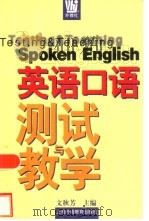
- 英语口语测试与教学
- 1999 上海:上海外语教育出版社
-
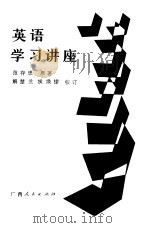
- 英语学习讲座
- 1985 南宁:广西人民出版社
-
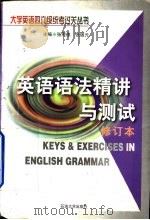
- 英语语法精讲与测试
- 1999 东营:石油大学出版社
-
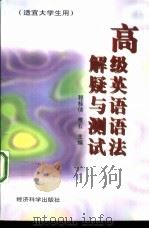
- 高级英语语法解疑与测试
- 1998 北京:经济科学出版社
-
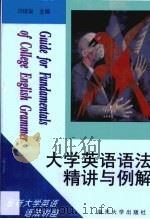
- 大学英语语法精讲与例解
- 1999 天津:南开大学出版社
-
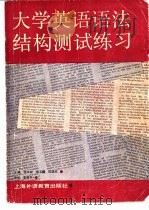
- 大学英语语法结构测试练习
- 1990 上海:上海外语教育出版社
-
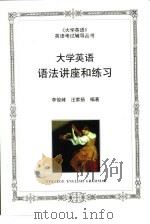
- 大学英语语法讲座和练习
- 1997 北京:兵器工业出版社
-

- 涉外商务礼仪
- 1999 上海:上海科学普及出版社
-

- 大学英语讲座
- 1984 南京:江苏科学技术出版社
-
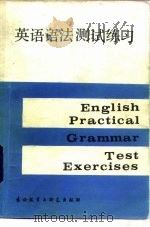
- 英语语法测试练习
- 1987 北京:外语教学与研究出版社
-
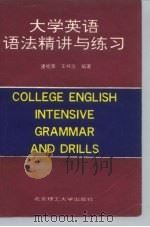
- 大学英语语法精讲与练习
- 1993 北京:北京理工大学出版社
-
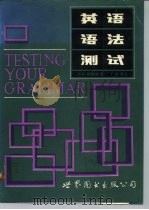
- 英语语法测试
- 1988 北京/西安:世界图书出版公司
-

- 大学英语应试语法
- 1999 北京:北京大学出版社
提示:百度云已更名为百度网盘(百度盘),天翼云盘、微盘下载地址……暂未提供。➥ PDF文字可复制化或转WORD